Event-Driven Coulomb Counting for Effective Online Approximation of Li-Ion Battery State of Charge †
Abstract
1. Introduction
2. Materials and Methods
2.1. Li-Ion Battery Model
2.2. Event-Driven Data Acquisition
2.3. Event-Driven Coulomb Counting
2.3.1. Conventional Approach
2.3.2. Proposed Approach
2.4. Evaluation Measures
2.4.1. Compression Ratio
2.4.2. Computational Complexity
2.4.3. Effectiveness of Fitting
2.4.4. SOC Estimation Error
3. Results
4. Discussion
5. Conclusions
Funding
Acknowledgments
Conflicts of Interest
Ethical Approval
References
- Nykvist, B.; Nilsson, M. Rapidly falling costs of battery packs for electric vehicles. Nat. Clim. Chang. 2015, 5, 329–332. [Google Scholar] [CrossRef]
- Li, M.; Lu, J.; Chen, Z.; Amine, K. 30 years of lithium-ion batteries. Adv. Mater. 2018, 30, 1800561. [Google Scholar] [CrossRef]
- Heubaum, H.; Biermann, F. Integrating global energy and climate governance: The changing role of the International Energy Agency. Energy Policy 2015, 87, 229–239. [Google Scholar] [CrossRef]
- Attia, P.M.; Grover, A.; Jin, N.; Severson, K.A.; Markov, T.M.; Liao, Y.-H.; Chen, M.H.; Cheong, B.; Perkins, N.; Yang, Z. Closed-loop optimization of fast-charging protocols for batteries with machine learning. Nature 2020, 578, 397–402. [Google Scholar] [CrossRef]
- Xiong, R.; Li, L.; Tian, J. Towards a smarter battery management system: A critical review on battery state of health monitoring methods. J. Power Sources 2018, 405, 18–29. [Google Scholar] [CrossRef]
- Qaisar, S.M. Efficient mobile systems based on adaptive rate signal processing. Comput. Electr. Eng. 2019, 79, 106462. [Google Scholar] [CrossRef]
- Seh, Z.W.; Sun, Y.; Zhang, Q.; Cui, Y. Designing high-energy lithium–sulfur batteries. Chem. Soc. Rev. 2016, 45, 5605–5634. [Google Scholar] [CrossRef]
- Dendouga, A. Conventional and Second Order Sliding Mode Control of Permanent Magnet Synchronous Motor Fed by Direct Matrix Converter: Comparative Study. Energies 2020, 13, 5093. [Google Scholar] [CrossRef]
- Ali, M.U.; Zafar, A.; Nengroo, S.H.; Hussain, S.; Junaid Alvi, M.; Kim, H.-J. Towards a smarter battery management system for electric vehicle applications: A critical review of lithium-ion battery state of charge estimation. Energies 2019, 12, 446. [Google Scholar] [CrossRef]
- Roscher, M.A.; Assfalg, J.; Bohlen, O.S. Detection of utilizable capacity deterioration in battery systems. IEEE Trans. Veh. Technol. 2010, 60, 98–103. [Google Scholar] [CrossRef]
- Hannan, M.A.; Lipu, M.H.; Hussain, A.; Mohamed, A. A review of lithium-ion battery state of charge estimation and management system in electric vehicle applications: Challenges and recommendations. Renew. Sustain. Energy Rev. 2017, 78, 834–854. [Google Scholar] [CrossRef]
- Qaisar, S. Electronic Management System for Rechargeable Battery has Measuring Circuit Measuring Parameter Determining Variation of Parameter Transmitting Data to Electronic Processing Unit if Variation is Higher than Predetermined Threshold. France Patent FR2959066A1, 2011. Available online: https://worldwide.espacenet.com/patent/search/family/042763477/publication/FR2959066A1?q=pn%3DFR2959066A1 (accessed on 25 October 2020).
- Zou, Z.; Xu, J.; Mi, C.; Cao, B.; Chen, Z. Evaluation of model based state of charge estimation methods for lithium-ion batteries. Energies 2014, 7, 5065–5082. [Google Scholar] [CrossRef]
- Ng, M.-F.; Zhao, J.; Yan, Q.; Conduit, G.J.; Seh, Z.W. Predicting the state of charge and health of batteries using data-driven machine learning. Nat. Mach. Intell. 2020, 2, 161–170. [Google Scholar] [CrossRef]
- Severson, K.A.; Attia, P.M.; Jin, N.; Perkins, N.; Jiang, B.; Yang, Z.; Chen, M.H.; Aykol, M.; Herring, P.K.; Fraggedakis, D. Data-driven prediction of battery cycle life before capacity degradation. Nat. Energy 2019, 4, 383–391. [Google Scholar] [CrossRef]
- Qaisar, S.M. A Proficient Li-Ion Battery State of Charge Estimation Based on Event-Driven Processing. J. Electr. Eng. Technol. 2020, 15, 1871–1877. [Google Scholar] [CrossRef]
- Qaisar, S.M.; Alshaiban, A. An Event Driven Approach for the Power Systems Energy Storage Monitoring. In Proceedings of the 2019 IEEE International Conference on Environment and Electrical Engineering and 2019 IEEE Industrial and Commercial Power Systems Europe (EEEIC/I&CPS Europe), Genova, Italy, 10–14 June 2019; pp. 1–4. [Google Scholar]
- Huria, T.; Ceraolo, M.; Gazzarri, J.; Jackey, R. High fidelity electrical model with thermal dependence for characterization and simulation of high power lithium battery cells. In Proceedings of the 2012 IEEE International Electric Vehicle Conference, Greenville, SC, USA, 4–8 March 2012; pp. 1–8. [Google Scholar]
- Yang, D.; Wang, Y.; Pan, R.; Chen, R.; Chen, Z. State-of-health estimation for the lithium-ion battery based on support vector regression. Appl. Energy 2018, 227, 273–283. [Google Scholar] [CrossRef]
- Wang, W.; Wang, D.; Wang, X.; Li, T.; Ahmed, R.; Habibi, S.; Emadi, A. Comparison of Kalman Filter-based state of charge estimation strategies for Li-Ion batteries. In Proceedings of the 2016 IEEE Transportation Electrification Conference and Expo (ITEC), Dearborn, MI, USA, 27–29 June 2016; pp. 1–6. [Google Scholar]
- Mian Qaisar, S. Échantillonnage et traitement conditionnés par le signal: Une approche prometteuse pour des traitements efficaces à pas adaptatifs. Ph.D. Thesis, Grenoble INPG, Grenoble, France, 2009. [Google Scholar]
- Qaisar, S.M.; AlQathami, M. Level-Crossing Sampling for Li-Ion Batteries Effective State of Health Estimation. In Proceedings of the 2020 19th International Conference on Harmonics and Quality of Power (ICHQP), Dubai, UAE, 22–25 March 2020; pp. 1–4. [Google Scholar]
- Zhang, R.; Xia, B.; Li, B.; Cao, L.; Lai, Y.; Zheng, W.; Wang, H.; Wang, W.; Wang, M. A study on the open circuit voltage and state of charge characterization of high capacity lithium-ion battery under different temperature. Energies 2018, 11, 2408. [Google Scholar] [CrossRef]
- Barillas, J.K.; Li, J.; Günther, C.; Danzer, M.A. A comparative study and validation of state estimation algorithms for Li-ion batteries in battery management systems. Appl. Energy 2015, 155, 455–462. [Google Scholar] [CrossRef]
- Miao, Z.; Xu, L.; Disfani, V.R.; Fan, L. An SOC-based battery management system for microgrids. IEEE Trans. Smart Grid 2013, 5, 966–973. [Google Scholar] [CrossRef]
- Weng, C.; Feng, X.; Sun, J.; Peng, H. State-of-health monitoring of lithium-ion battery modules and packs via incremental capacity peak tracking. Appl. Energy 2016, 180, 360–368. [Google Scholar] [CrossRef]
- Phillip, N.D.; Westover, A.S.; Daniel, C.; Veith, G.M. Structural Degradation of High Voltage Lithium Nickel Manganese Cobalt Oxide (NMC) Cathodes in Solid-State Batteries and Implications for Next Generation Energy Storage. ACS Appl. Energy Mater. 2020, 3, 1768–1774. [Google Scholar] [CrossRef]
- Esfandiari, R.S.; Lu, B. Modeling and Analysis of Dynamic Systems; CRC Press: Boca Raton, FL, USA, 2018; ISBN 1-351-75164-6. [Google Scholar]
- Hahn, B.; Valentine, D. Essential MATLAB for Engineers and Scientists; Academic Press: Cambridge, MA, USA, 2016; ISBN 0-12-805271-6. [Google Scholar]
- Warner, J.T. The Handbook of Lithium-Ion Battery Pack Design: Chemistry, Components, Types and Terminology; Elsevier: Amsterdam, The Netherlands, 2015; ISBN 0-12-801668-X. [Google Scholar]
- Zhang, Y.; Song, W.; Lin, S.; Feng, Z. A novel model of the initial state of charge estimation for LiFePO4 batteries. J. Power Sources 2014, 248, 1028–1033. [Google Scholar] [CrossRef]
- He, H.; Zhang, X.; Xiong, R.; Xu, Y.; Guo, H. Online model-based estimation of state-of-charge and open-circuit voltage of lithium-ion batteries in electric vehicles. Energy 2012, 39, 310–318. [Google Scholar] [CrossRef]
- Tian, Y.; Xia, B.; Sun, W.; Xu, Z.; Zheng, W. A modified model based state of charge estimation of power lithium-ion batteries using unscented Kalman filter. J. Power Sources 2014, 270, 619–626. [Google Scholar] [CrossRef]
- Bi, Y.; Choe, S.-Y. An adaptive sigma-point Kalman filter with state equality constraints for online state-of-charge estimation of a Li (NiMnCo) O2/Carbon battery using a reduced-order electrochemical model. Appl. Energy 2020, 258, 113925. [Google Scholar] [CrossRef]
- Wang, L.; Lu, D.; Liu, Q.; Liu, L.; Zhao, X. State of charge estimation for LiFePO4 battery via dual extended kalman filter and charging voltage curve. Electrochim. Acta 2019, 296, 1009–1017. [Google Scholar] [CrossRef]
- Hu, X.; Jiang, H.; Feng, F.; Liu, B. An enhanced multi-state estimation hierarchy for advanced lithium-ion battery management. Appl. Energy 2020, 257, 114019. [Google Scholar] [CrossRef]
- Ning, B.; Cao, B.; Wang, B.; Zou, Z. Adaptive sliding mode observers for lithium-ion battery state estimation based on parameters identified online. Energy 2018, 153, 732–742. [Google Scholar] [CrossRef]
- How, D.N.T.; Hannan, M.A.; Lipu, M.S.H.; Ker, P.J. State of Charge Estimation for Lithium-Ion Batteries Using Model-Based and Data-Driven Methods: A Review. IEEE Access 2019, 7, 136116–136136. [Google Scholar] [CrossRef]
- Meher, P.K.; Stouraitis, T. Arithmetic Circuits for DSP Applications; John Wiley & Sons: New York, NY, USA, 2017; ISBN 1-119-20677-4. [Google Scholar]
- Baccouche, I.; Jemmali, S.; Manai, B.; Omar, N.; Amara, N.E.B. Improved OCV model of a Li-ion NMC battery for online SOC estimation using the extended Kalman filter. Energies 2017, 10, 764. [Google Scholar] [CrossRef]
- Lei, H.; Han, Y.Y. The measurement and analysis for Open Circuit Voltage of Lithium-ion Battery. J. Phys. Conf. Ser. 2019, 1325, 012173. [Google Scholar] [CrossRef]
- Wu, K.; Niu, X.; Wang, J.; Wu, K.; Jia, S. Electric Vehicle Load Characteristic Analysis and Impact of Regional Power Grid. In Proceedings of the 2nd International Conference on Electronic & Mechanical Engineering and Information Technology, Shenyang, China, 7 September 2012. [Google Scholar]
- Bø, T.I.; Johansen, T.A. Battery power smoothing control in a marine electric power plant using nonlinear model predictive control. IEEE Trans. Control Syst. Technol. 2016, 25, 1449–1456. [Google Scholar] [CrossRef]
- Ndjountche, T. Data Converters, Phase-Locked Loops, and Their Applications; CRC Press: Boca Raton, FL, USA, 2018; ISBN 0-429-93904-3. [Google Scholar]
- Gu, P.; Zhou, Z.; Qu, S.; Zhang, C.; Duan, B. Influence Analysis and Optimization of Sampling Frequency on the Accuracy of Model and State-of-Charge Estimation for LiNCM Battery. Energies 2019, 12, 1205. [Google Scholar] [CrossRef]



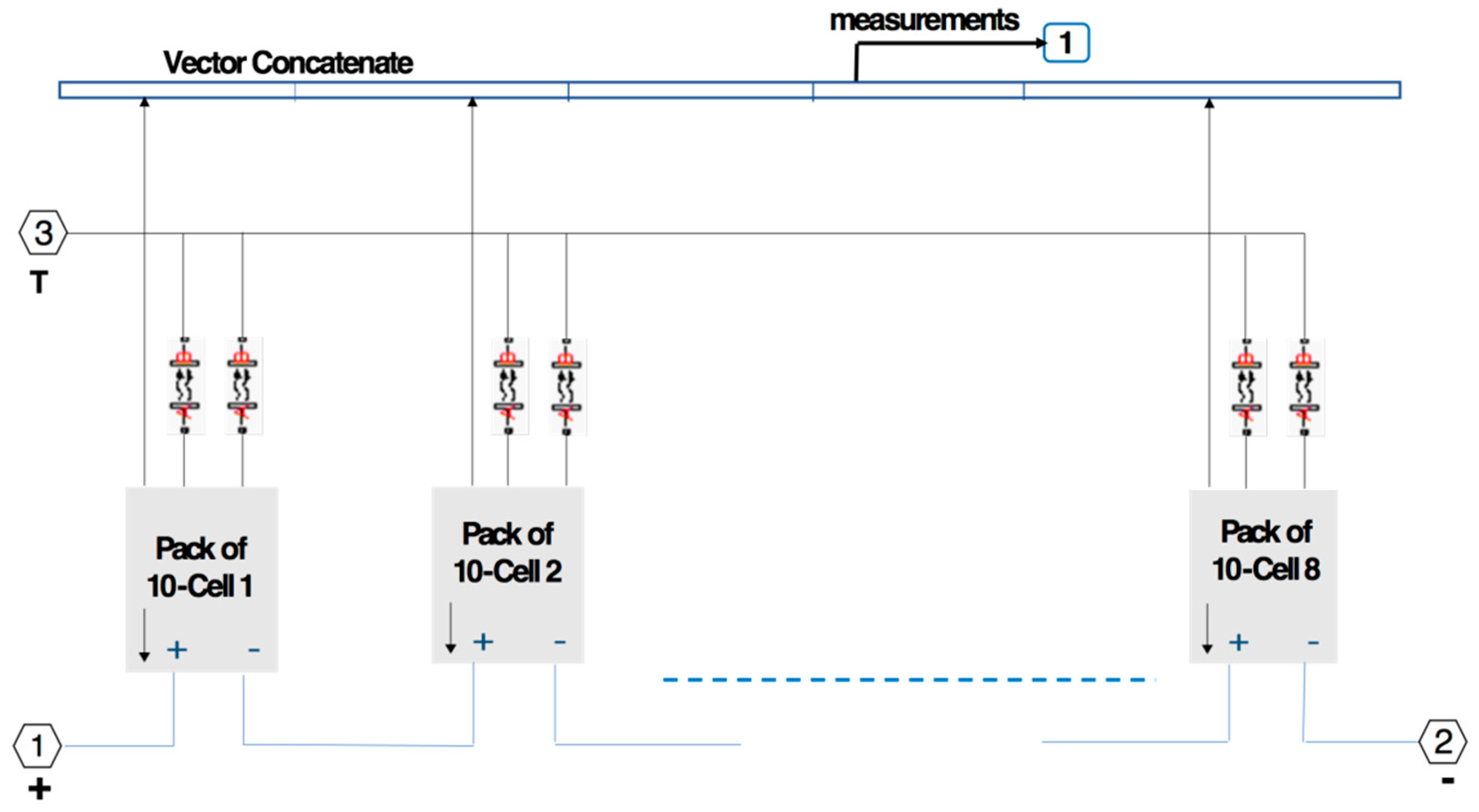
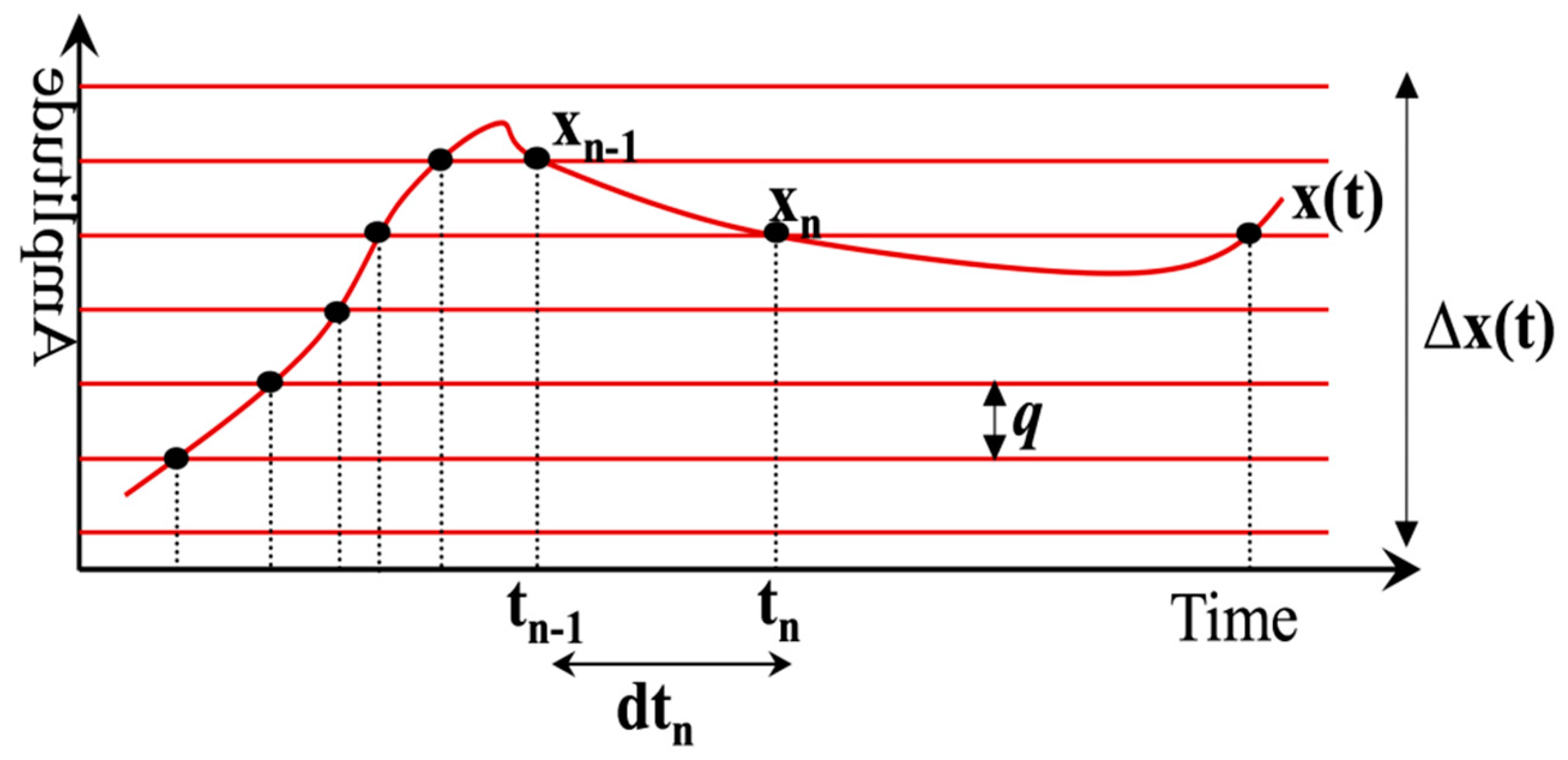

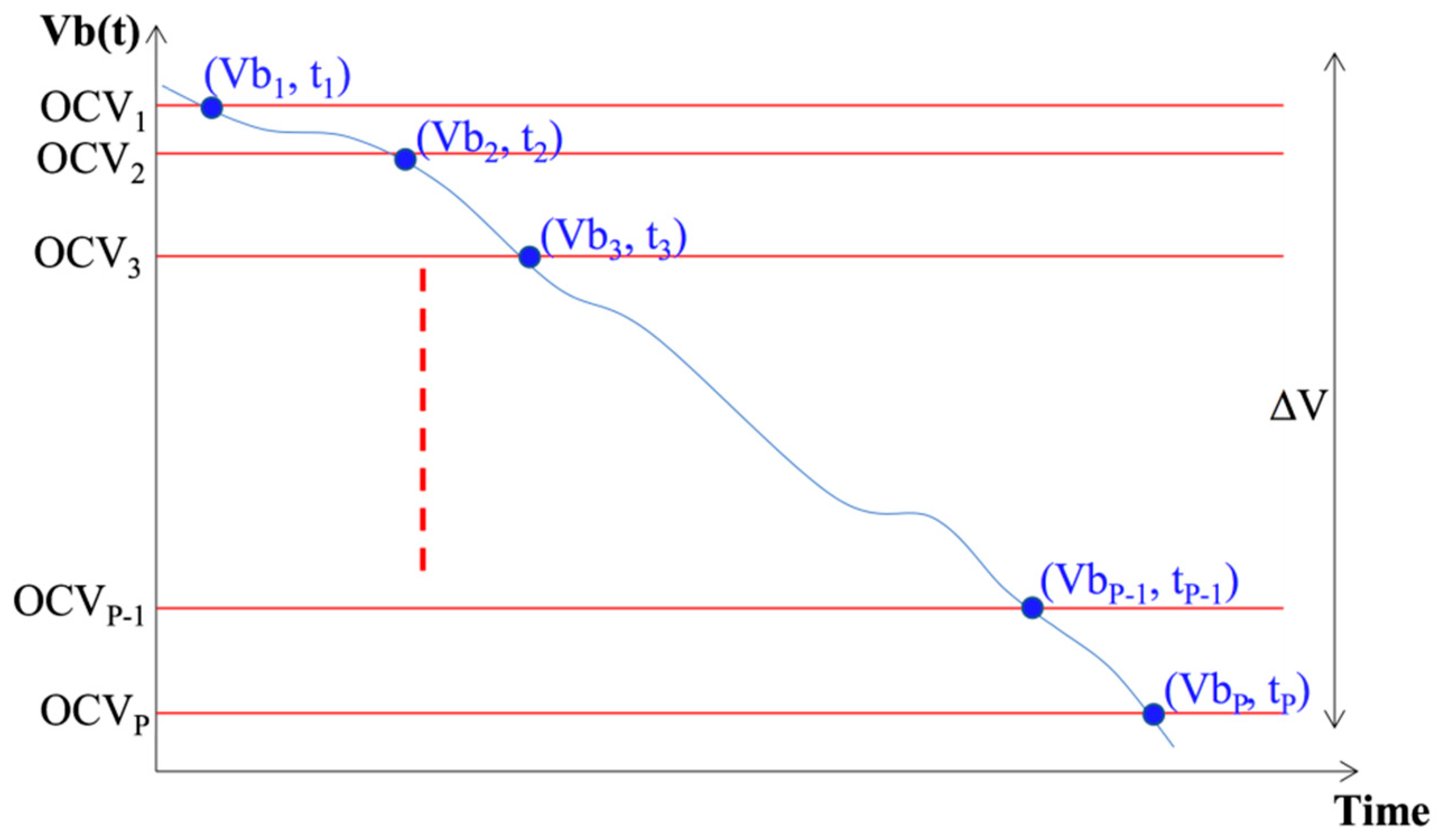


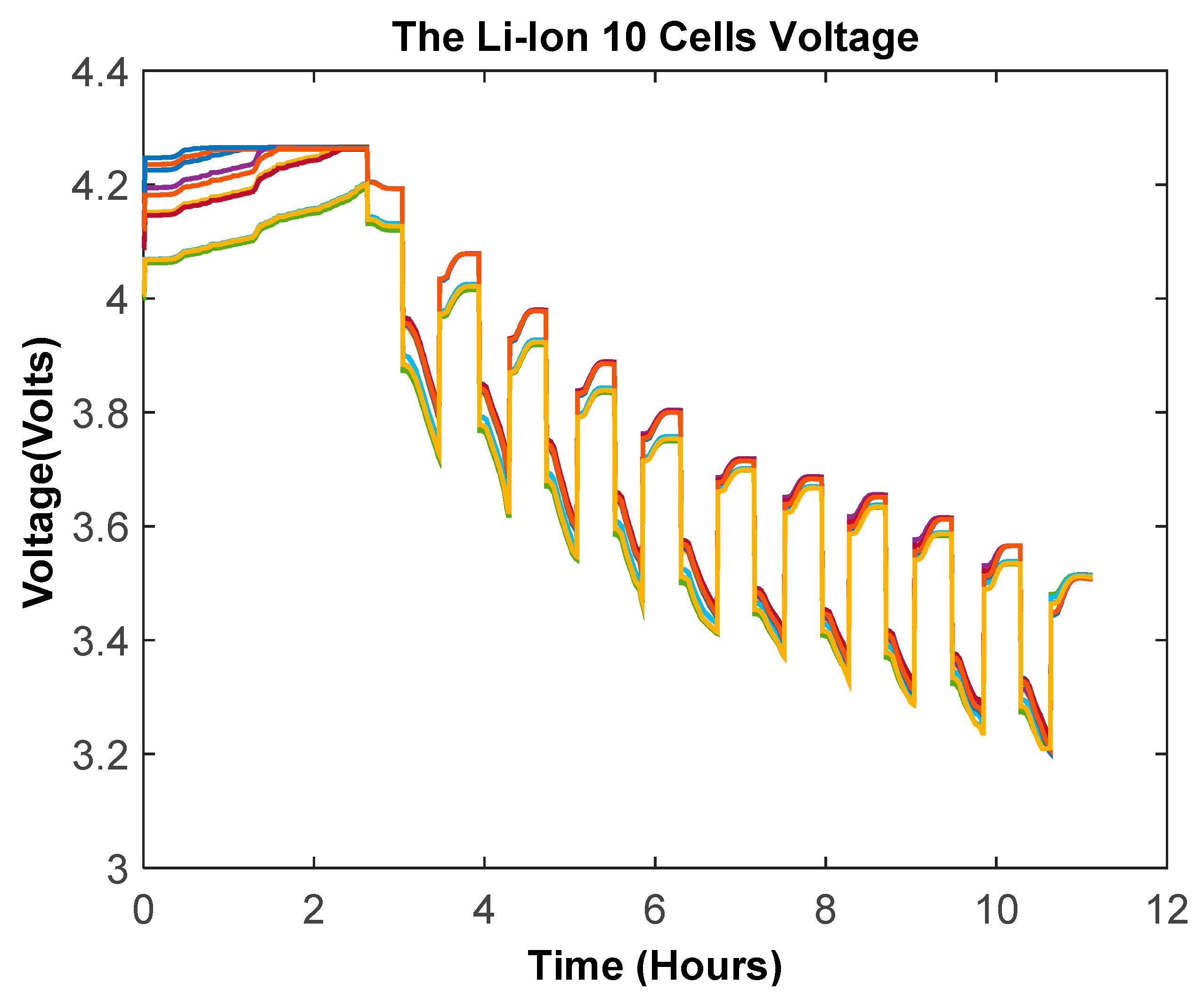

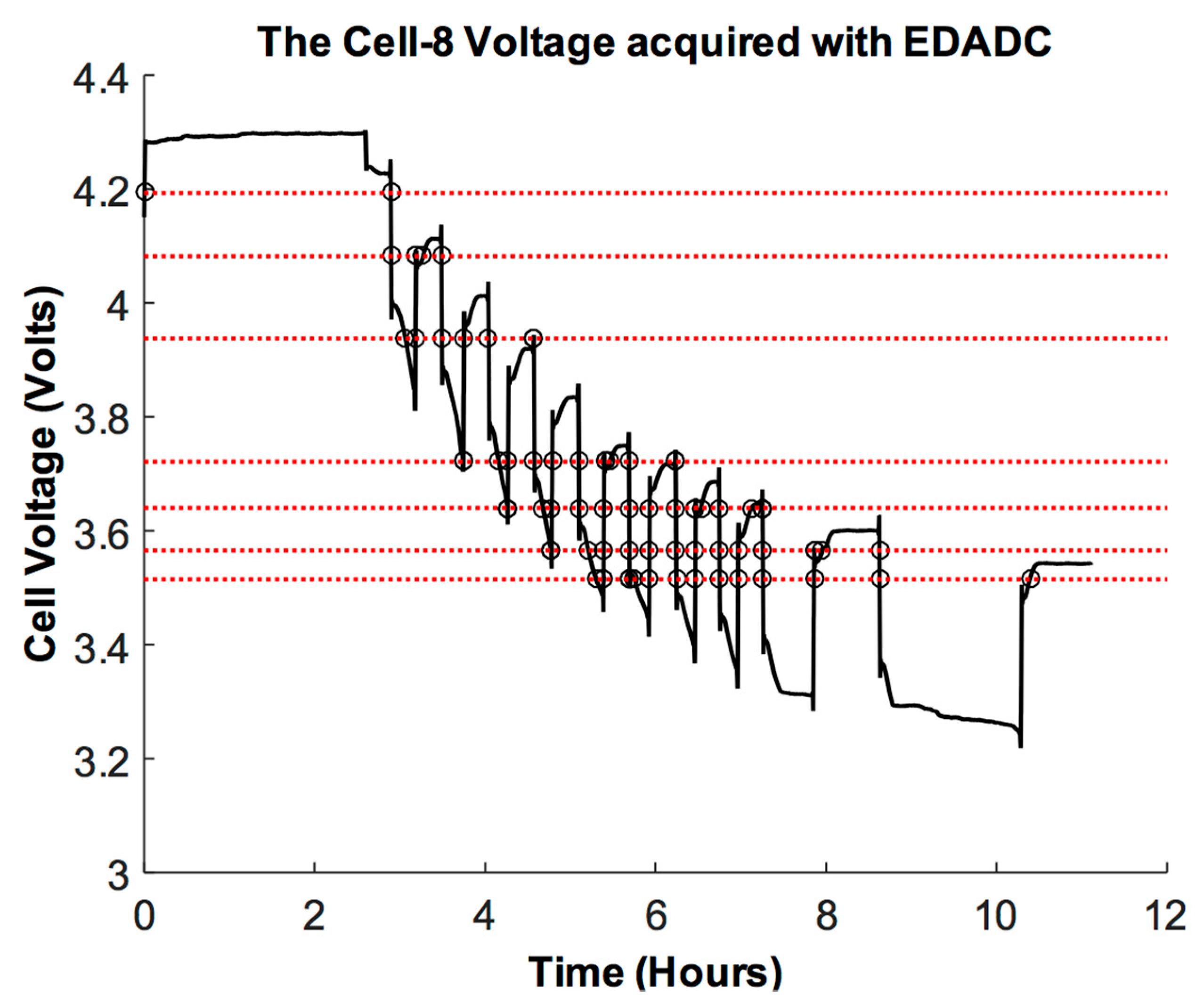

| SOC-V | SOC1 | SOC2 | SOC3 | SOC4 | SOC5 | SOC6 | SOC7 |
|---|---|---|---|---|---|---|---|
| (%) | 100 | 90 | 75 | 50 | 25 | 10 | 0 |
| OCV-V | OCV1 | OCV2 | OCV3 | OCV4 | OCV5 | OCV6 | OCV7 |
| Volts (V) | 4.20 | 4.10 | 3.90 | 3.70 | 3.60 | 3.50 | 3.45 |
| Operation | Minimum Gain | Maximum Gain | Average Gain | STD | Total Gain |
|---|---|---|---|---|---|
| Additions | 436.01 | 440.31 | 437.99 | 1.49 | 35.04 × 103 |
| Multiplications | 4.13 | 4.21 | 4.17 | 0.03 | 333.28 |
| Comparisons | 9.01 | 9.39 | 9.19 | 0.13 | 735.01 |
| Solution | Minimum | Maximum | Average | STD |
|---|---|---|---|---|
| Classical | 2.3% | 2.8% | 2.51% | 0.21 |
| Event-Driven | 3.6% | 4.0% | 3.77% | 0.17 |
| Study | SOC Estimation Method | Upper Bound on Error |
|---|---|---|
| [31] | Coulomb counting | ≤4% |
| [32] | Recursive least squares algorithm | ≤5% |
| [33] | Unscented Kalman filter | ≤4% |
| [34] | Adaptive sigma-point Kalman filter and state equality constraints | ≤2% |
| [35] | Dual extended Kalman filtering | ≤3% |
| [36] | Modified moving horizon estimation | ≤3% |
| [37] | Adaptive sliding mode observer | ≤2% |
| Proposed solution | Event-driven coulomb counting | ≤4% |
Publisher’s Note: MDPI stays neutral with regard to jurisdictional claims in published maps and institutional affiliations. |
© 2020 by the author. Licensee MDPI, Basel, Switzerland. This article is an open access article distributed under the terms and conditions of the Creative Commons Attribution (CC BY) license (http://creativecommons.org/licenses/by/4.0/).
Share and Cite
Mian Qaisar, S. Event-Driven Coulomb Counting for Effective Online Approximation of Li-Ion Battery State of Charge. Energies 2020, 13, 5600. https://doi.org/10.3390/en13215600
Mian Qaisar S. Event-Driven Coulomb Counting for Effective Online Approximation of Li-Ion Battery State of Charge. Energies. 2020; 13(21):5600. https://doi.org/10.3390/en13215600
Chicago/Turabian StyleMian Qaisar, Saeed. 2020. "Event-Driven Coulomb Counting for Effective Online Approximation of Li-Ion Battery State of Charge" Energies 13, no. 21: 5600. https://doi.org/10.3390/en13215600
APA StyleMian Qaisar, S. (2020). Event-Driven Coulomb Counting for Effective Online Approximation of Li-Ion Battery State of Charge. Energies, 13(21), 5600. https://doi.org/10.3390/en13215600






